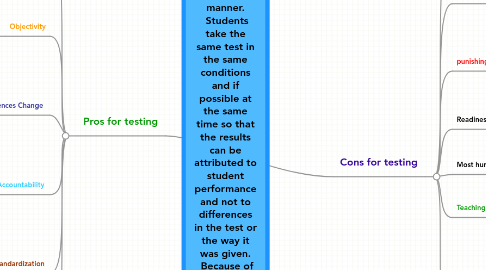
1. Pros for testing
1.1. Practicality
1.1.1. Less time consuming
1.1.2. Easy to adminisiter
1.1.3. Easy to grade
1.1.4. Easy to track progress and levels of achievement.
1.1.5. Cost effective
1.2. Objectivity
1.2.1. Scores are based on the objectivity of the test not the emotions of a human.
1.2.2. Historically, non-standardized tests used in other countries were full of bias.
1.3. Influences Change
1.3.1. Standardized tests can be a powerful tool to promote changes in schools.
1.3.2. Results are indicators of problems
1.3.3. Schools use test result data to make changes to improve the learning strategies in their classrooms
1.4. Accountability
1.4.1. Forces students and teachers to take education seriously
1.4.2. Sets high standards and achievement goals for students and teachers to work towards
1.5. Standardization
1.5.1. Tests are the same for all children in each grade level regardless of the demographic in the classroom
1.5.2. Levels the playing field
1.5.3. Ensures that all students in the same grade are exposed to the same concepts.
1.6. Promotes learning
1.6.1. Motivates students to learn, because they know they will be tested
1.6.2. Influences cognitive processing
2. Cons for testing
2.1. dishonesty
2.1.1. schools do not have to include scores of students w/special needs.. & can find ways of why they don't need ot take the the test. (red handout)
2.2. emotional effects
2.2.1. after doing poorly on a test, low- achieivng students become disilllusioned and less motivated which leads to less effort to learn. No motivation to work towards next test & negative emotion toward learning. Teachers even admit to developing negative attitude towards students that do not perform at an acceptable level.
2.3. punishing schools & students
2.3.1. this is done by federal taking over the school, removing resources, etc... instead of spending time helping those students and schools improve (red handout)
2.4. Readiness tests
2.4.1. used to see if a child is ready for school is inaccurate adn encourage the use of overly academic, developmentally inappropriate primary schooling ( basically schooling that is not emotionally, socially, or intellectually appropriate for the child) black handout)
2.5. Most hurt by the tests
2.5.1. low income and minority group students
2.6. Teaching the test
2.6.1. narrows the curriculum & forces more on memorization of isolated facts
2.6.2. reduces critical thinking and indepth thinking (green handout)
2.7. Kindergarten testing
2.7.1. usually the first time children are tested and if don't do well may be retained or placed in K-1 class... the thought is that teachers will gain information from these tests on the children but in reality little comes from these tests so it is of little help for this age. (purple handout)
2.7.2. 1st 8 yrs of life, there is a great deal of variablitlity in how a child learns (grey handout)
2.7.3. subject to have they feel so test scores can be affected
2.7.4. have short attention spans (dark purple)
2.7.5. trouble following muliple step directions
